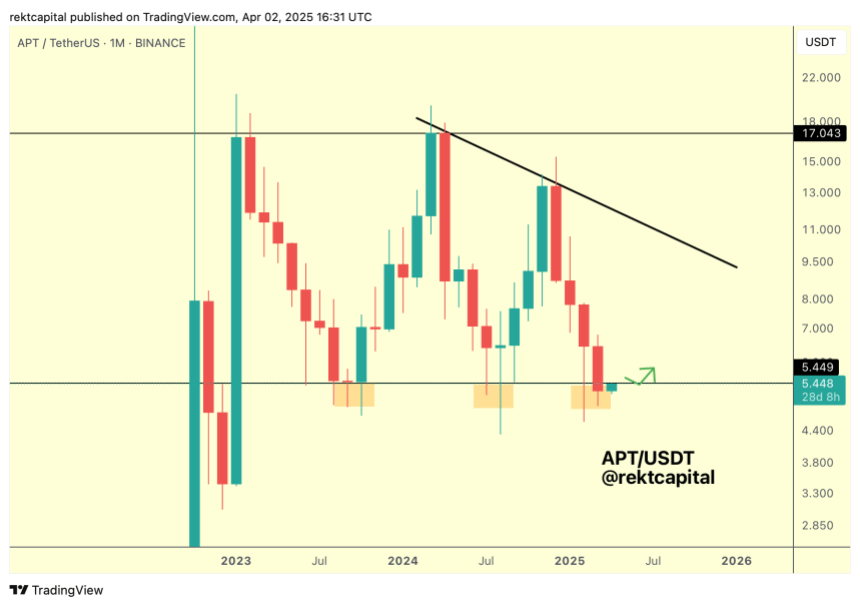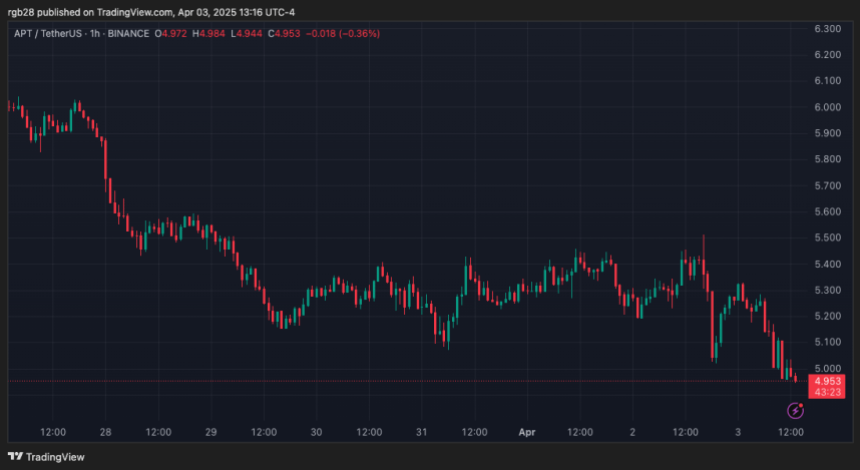Bitcoin
Coinbase Stocks Slide Over 30% This Quarter, Matching Post-FTX Collapse Lows
Published
4 days agoon
By
admin
Reason to trust

Strict editorial policy that focuses on accuracy, relevance, and impartiality
Created by industry experts and meticulously reviewed
The highest standards in reporting and publishing
Strict editorial policy that focuses on accuracy, relevance, and impartiality
Morbi pretium leo et nisl aliquam mollis. Quisque arcu lorem, ultricies quis pellentesque nec, ullamcorper eu odio.
Shares of Coinbase (COIN), the largest crypto exchange in the US, have faced significant declines during the first quarter (Q1) of the year, primarily due to escalating concerns about the US economy and its impact on digital assets.
Coinbase And Others Face Increased Volatility
According to Bloomberg, Coinbase’s stock has dropped more than 30% since the beginning of the quarter, marking its worst performance since the collapse of the FTX exchange in late 2022.
This decline is reflective of a broader trend affecting nearly all major crypto-linked stocks, including companies like Galaxy Digital Holdings (GLXY.TO), Riot Platforms (RIOT), and Core Scientific (CORZ).
Related Reading
The cryptocurrency market itself is experiencing turmoil, with Bitcoin (BTC) falling over 20% from its all-time high and Ethereum (ETH) plummeting more than 45% in value.
These shifts come amid President Donald Trump’s escalation of a “global trade war,” which has stirred fears about the health of the country’s economy. Economic data has exacerbated these concerns, pushing the S&P 500 Index (GSPC) toward its worst quarter since mid-2022.
Oppenheimer analyst Owen Lau noted that many within the cryptocurrency community recognize that the current market conditions are not primarily driven by fundamental factors. Instead, Lau emphasized that macroeconomic issues—such as tariffs and the potential trade war—are influencing investor sentiment significantly.
The looming threat of a recession has reportedly added to the unease, causing higher-risk crypto-linked stocks to be even more volatile than Bitcoin itself.
Lau explains that investments in companies like Coinbase carry additional risks, including the potential for bankruptcy, allegedly making them particularly susceptible to swift sell-offs.
Cryptocurrency Market Struggles To Rebound
The current state of the cryptocurrency market is a stark contrast to the optimism that prevailed at the start of the year, following Trump’s election. Bitcoin reached a record high of over $109,000 on Inauguration Day.
Earlier this month, Bitcoin prices fell after Trump announced a strategic reserve for the market’s leading crypto, but did not allocate taxpayer funds to expand it. As of now, Bitcoin trades around $83,000, still above pre-election levels but far from its peak.
Related Reading
While shares of various crypto-related companies surged following the election, Coinbase and crypto miners have since relinquished those gains. Notably, Michael Saylor’s Strategy (MSTR) is among the few stocks in the sector that has managed to remain in positive territory since November 5.
Despite the downturn, the cryptocurrency industry continues to gain influence in Washington and is moving closer to integration with traditional financial systems. However, this growing power has yet to translate into a market rebound.
Connor Loewen, a cryptocurrency analyst at 3iQ, expressed skepticism about the current state of investor sentiment, stating, “What we saw a couple of months ago, I don’t know how much crazier it can get than that. I think we’re going to have to be looking for new catalysts.”
Featured image from DALL-E, chart from TradingView.com
Source link
You may like


Toncoin Takes A Hit With 12% Correction After Failing To Break $4.34, More Pain?


Bitcoin sentiment falls to 2023 low, but ‘risk on’ environment may emerge to spark BTC price rally


Crypto Trader Says Dogecoin Is at a Critical ‘Make-or-Break’ Level, Updates Outlook on Solana and Avalanche


Bitcoin Covenants: CHECKSIGFROMSTACK (BIP 348)


Illinois State Senator’s Bill Seeks to Claw Back $163 Million Lost to Crypto Fraud


Here’s why Bitcoin, altcoins, and the stock market continued falling on Friday
Altcoin
Here’s why Bitcoin, altcoins, and the stock market continued falling on Friday
Published
4 hours agoon
April 4, 2025By
admin

Bitcoin, altcoins, and the stock market continued their downward trend on Friday as the trade war between the U.S. and China escalated.
Bitcoin (BTC) price dropped to $82,000, erasing some of the gains made during the Asian and European markets. Ethereum (ETH) dropped below $1,800, while the market cap of all coins fell to $2.64 trillion.
The stock market’s performance was even worse as futures tied to the Dow Jones, S&P 500, and Nasdaq 100 indices plunged by over 3%. This means that these blue-chip indices have all moved into a correction.
Trade war escalates
Bitcoin, altcoins, and equities declined after China announced its retaliatory measures against the U.S. In a statement, Beijing said it would impose a 34% tariff on all goods imported from the U.S.
In addition, China will restrict exports of certain rare earth minerals, halt sorghum imports from U.S. companies, and add 11 American firms to its unreliable entity list.
These measures mark the most significant response to Donald Trump’s Liberation Day tariffs. Other countries, especially those in Europe, have called for negotiations to prevent the trade war from expanding.
Trump and senior officials have warned that the U.S. will deliver reciprocal tariffs on any country that retaliates. They’ve urged trading partners to lower their tariffs and non-tariff barriers instead.
Therefore, Bitcoin, altcoins, and the stock market are falling as these actions lead to higher odds of a recession. Polymarket data shows that traders have boosted their recession odds to 56%. Companies like Goldman Sachs and PIMCO have also boosted their recession odds.
These fears have pushed market sentiment into extreme territory. The CNN Money Fear and Greed Index dropped to 6, the lowest reading since the onset of the COVID-19 pandemic.
Investor pessimism intensified after billionaire and former Bond King Bill Gross warned against buying the dip. He said:
“Investors should not try to ‘catch a falling knife. This is an epic economic and market event similar to 1971 and the end of the gold standard except with immediate negative consequences.”
Bitcoin, altcoins, and the stock market fall after NFP data
Markets also weakened after the U.S. released the latest nonfarm payrolls (NFP) report. The data showed that unemployment rose to 4.2% in March, up from 4.1% in February.
The economy added 228,000 jobs, beating analysts’ median forecast of 137,000. However, the manufacturing sector, which Trump aims to protect with his tariff policy, created just 1,000 jobs.
These figures will likely have minimal impact on the Federal Reserve, which remains focused on inflation and GDP growth.
Meanwhile, the bond market is signaling expectations of lower interest rates. The 10-year Treasury yield fell to 3.89%, while the 30-year and 2-year yields declined to 4.38% and 3.5%, respectively. If the Fed cuts rates, it would likely be bullish for Bitcoin, altcoins, and the broader stock market.
Source link
Bitcoin
Bitcoin Falls Back to $83K, XRP, SOL, DOGE Surrender Gains as China Announces 34% Tariffs on All U.S. Goods
Published
6 hours agoon
April 4, 2025By
admin

Risk sentiment worsened during the European hours Friday after China announced retaliatory tariffs on all goods, responding to Trump’s Wednesday decision to boost the overall levy on Chinese goods to 54%.
Bitcoin, the leading cryptocurrency by market value, fell by $1,600 to $83,000, erasing the early rise to $84,600, CoinDesk data shows. Other tokens like XRP, ETH, SOL and DOGE also reversed early gains to trade largely flat on the day.
Meanwhile, futures tied to the S&P 500 and Nasdaq fell over 2% amid escalating global trade tensions.
“China’s response is not only negative for the U.S. but it is also impacting the global outlook,” ForexLive’s analyst Justin Low wrote in a market update.
Source link
APT
Analysts Eye 20% Breakout If This Level Is Reclaimed
Published
8 hours agoon
April 4, 2025By
admin
Reason to trust

Strict editorial policy that focuses on accuracy, relevance, and impartiality
Created by industry experts and meticulously reviewed
The highest standards in reporting and publishing
Strict editorial policy that focuses on accuracy, relevance, and impartiality
Morbi pretium leo et nisl aliquam mollis. Quisque arcu lorem, ultricies quis pellentesque nec, ullamcorper eu odio.
Amid the market retrace, Aptos (APT) has seen an 8% decline in the past 24 hours, falling below a key support zone for the second time this week. Despite the correction, some analysts consider that the cryptocurrency could be poised for a breakout soon.
Related Reading
Aptos Loses Macro Range Lows
During the March retraces, Aptos fell below a crucial support level for the first time since August 2024 but recovered 24% near the end of the month. However, APT followed the rest of the market and dumped 11% to close the March below key levels.
Analyst Rekt Capital noted that APT closed last month below its Macro Range Low of $5.44 for the first time. The cryptocurrency has been trading within the $5.45-$17 price range since 2023, retesting the range lows two times before.
Historically, “APT tends to develop bases here in the form of downside wicks for three-month periods,” he explained, adding that the cryptocurrency seems to be developing a third three-month base, with the difference that it has closed below this range for the first time in the monthly timeframe.

Following this performance, Aptos will need to reclaim the $5.44 level as support “to end this Monthly close as a downside deviation” and “avoid a bearish retest here.”
Previously, the analyst suggested that holding this level could reverse ATP’s price action in the coming months, as it has done with the other clusters. Additionally, he pointed out the previous consolidations included a “downside wicking below support.”
In his recent analysis, Rekt Capital considers that APT’s daily bullish divergence “is still something worth watching” as the cryptocurrency’s Relative Strength Index (RSI) continues to form Higher Lows despite the recent downside deviation, and its price “is trying to transition away from Lower Lows into a new Higher Low.”
According to the analyst, “a clear market structure is developing here, and a breakout from it would validate the Bull Div and set APT up for a reclaim of the Macro Range Low of $5.44,” which is key for a bullish rally.
APT To Reclaim $6.5 Resistance?
Analyst Sjuul from AltCryptoGems highlighted Aptos’ strength amid the market volatility, which saw Bitcoin (BTC) drop from $88,000 to $81,000 in the past 24 hours. APT dropped from the $5.40 mark to the $4.95 support.
The analyst considers that a retest of the local range lows could be necessary before the cryptocurrency aims for the next crucial level, as the current price zone has been tested many times.
Related Reading
Moreover, a reclaim of the $5.44 range could see the APT surge another 20% to the $6.5 resistance lost two months ago. Another market watcher suggested that Aptos is “showing potential for a bullish breakout as it trades within a descending channel.”
Per the chart, the cryptocurrency has been trading within a descending channel since early February, testing the channel’s lower and upper boundaries throughout March. “After testing the lower trendline, it may be finding support, and a break above the upper resistance will signal a significant rally,” the analyst concluded.
As of this writing, Aptos trades at $5.02, a 16.1% decline in the weekly timeframe.

Featured Image from Unsplash.com, Chart from TradingView.com
Source link

Toncoin Takes A Hit With 12% Correction After Failing To Break $4.34, More Pain?

Bitcoin sentiment falls to 2023 low, but ‘risk on’ environment may emerge to spark BTC price rally

Crypto Trader Says Dogecoin Is at a Critical ‘Make-or-Break’ Level, Updates Outlook on Solana and Avalanche

Bitcoin Covenants: CHECKSIGFROMSTACK (BIP 348)

Illinois State Senator’s Bill Seeks to Claw Back $163 Million Lost to Crypto Fraud

Here’s why Bitcoin, altcoins, and the stock market continued falling on Friday

Bitcoin Falls Back to $83K, XRP, SOL, DOGE Surrender Gains as China Announces 34% Tariffs on All U.S. Goods

BTC Holds $84K, ATOM & FIL Become Top Gainers

Analysts Eye 20% Breakout If This Level Is Reclaimed

AI and blockchain — A match made in heaven

‘We’re Still in Danger Territory’: Crypto Analyst Unveils Bearish Setup for Bitcoin – Here Are His Targets

Bitcoin Startups Raised Nearly $1.2 Billion

Illinois to End Lawsuit Against Coinbase Over Staking Program: Report

Justin Sun takes legal action against FDUSD issuer
Not a Meme! DePIN Can Take Crypto Mainstream

Arthur Hayes, Murad’s Prediction For Meme Coins, AI & DeFi Coins For 2025

Expert Sees Bitcoin Dipping To $50K While Bullish Signs Persist

Aptos Leverages Chainlink To Enhance Scalability and Data Access

Bitcoin Could Rally to $80,000 on the Eve of US Elections

Sonic Now ‘Golden Standard’ of Layer-2s After Scaling Transactions to 16,000+ per Second, Says Andre Cronje

Institutional Investors Go All In on Crypto as 57% Plan to Boost Allocations as Bull Run Heats Up, Sygnum Survey Reveals

Crypto’s Big Trump Gamble Is Risky

Ripple-SEC Case Ends, But These 3 Rivals Could Jump 500x

Has The Bitcoin Price Already Peaked?

A16z-backed Espresso announces mainnet launch of core product

Xmas Altcoin Rally Insights by BNM Agent I

Blockchain groups challenge new broker reporting rule

The Future of Bitcoin: Scaling, Institutional Adoption, and Strategic Reserves with Rich Rines

Trump’s Coin Is About As Revolutionary As OneCoin

Is $200,000 a Realistic Bitcoin Price Target for This Cycle?
Trending

 24/7 Cryptocurrency News5 months ago
24/7 Cryptocurrency News5 months agoArthur Hayes, Murad’s Prediction For Meme Coins, AI & DeFi Coins For 2025

 Bitcoin3 months ago
Bitcoin3 months agoExpert Sees Bitcoin Dipping To $50K While Bullish Signs Persist

 24/7 Cryptocurrency News3 months ago
24/7 Cryptocurrency News3 months agoAptos Leverages Chainlink To Enhance Scalability and Data Access

 Bitcoin5 months ago
Bitcoin5 months agoBitcoin Could Rally to $80,000 on the Eve of US Elections

 Altcoins2 months ago
Altcoins2 months agoSonic Now ‘Golden Standard’ of Layer-2s After Scaling Transactions to 16,000+ per Second, Says Andre Cronje

 Bitcoin5 months ago
Bitcoin5 months agoInstitutional Investors Go All In on Crypto as 57% Plan to Boost Allocations as Bull Run Heats Up, Sygnum Survey Reveals

 Opinion5 months ago
Opinion5 months agoCrypto’s Big Trump Gamble Is Risky

 Price analysis5 months ago
Price analysis5 months agoRipple-SEC Case Ends, But These 3 Rivals Could Jump 500x


